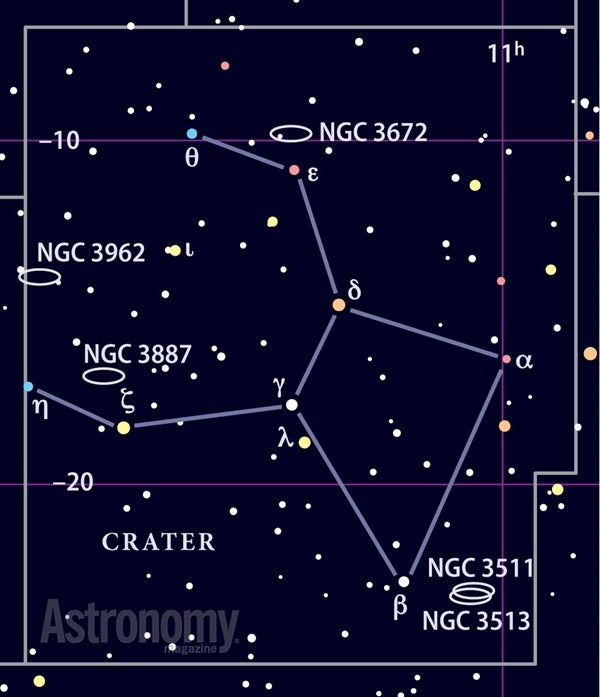Targets for March 13–20, 2014
Naked eyes: The constellation Crater
Small telescope: The Spindle Galaxy (NGC 3115)
Large telescope: Irregular galaxy Sextans B
This week’s naked-eye object is the constellation Crater the Cup. Five constellations border Crater: Corvus the Crow, Hydra the Water Snake, Leo the Lion, Sextans the Sextant, and Virgo the Maiden.
Crater lies in the mid-range of constellation sizes. It ranks as the 53rd largest of the 88 constellations that cover the sky. It envelops 282 square degrees; that’s 0.685 percent of the sky.
Crater also ranks near the bottom in terms of star brightness per unit area. It ranks 82nd. This meager constellation contains just one named star — Alkes — and none of the 200 brightest stars. In all, Crater contains only 11 stars brighter than magnitude 5.5.
As the only named star in the constellation, Alkes may have been brighter four centuries ago. In 1603, German celestial cartographer Johannes Bayer designated it Alpha (α) Crateris. Today, Delta (δ) Crateris is the constellation’s brightest star with an apparent magnitude of 3.6. Alkes is half a magnitude fainter at magnitude 4.1.
The best single date to see Crater is March 12. Its visibility peaks in late winter, when it lies highest in the sky. Through March, its part of the sky lies opposite the Sun, and it’s visible most of the night. The worst time to look for Crater is around September 10. That’s when it lies in the same direction as the Sun.
This constellation is visible by people on most of Earth’s surface. It’s completely visible from areas south of latitude 65° north. It’s only invisible for people who live north of latitude 84° north.
A luminous spindle
This week’s small telescope target is the Spindle Galaxy in Sextans. Astronomers usually refer to it as NGC 3115. It made British astronomer Sir Patrick Moore’s “Caldwell” list of deep-sky objects as his number 53.
Not only is the Spindle Galaxy the showpiece of Sextans, it’s one of the sky’s brightest galaxies. In fact, most observers can hardly believe Charles Messier failed to include it in his catalog.
NGC 3115 is the prototype S0 galaxy, a class that American astronomer Edwin Hubble used to bridge the gap between the flattest ellipticals and spirals. Such objects have a large central bulge and long extensions (like the type of spindle that holds thread or yarn) but no spiral arms.
At magnitude 8.9, NGC 3115 is so bright that you can spot it through binoculars or a finder scope. Through a 4-inch telescope, you’ll see an object four times as long as it is wide with a bright center. The galaxy measures 8.1′ by 2.8′. Through a larger scope at 300x, the central bulge appears more distinct, an oval bulge surrounds the center, and a faint oval glow surrounds the entire object.
You’ll find the Spindle Galaxy 3.2° east of magnitude 5.1 Gamma (γ) Sextantis.
Nearby, but still faint
This week’s large telescope target is the irregular galaxy called Sextans B, which lies in the constellation Sextans.
To find this galaxy, look 6° north-northwest of magnitude 4.5 Alpha Sextantis. Sextans B glows softly at magnitude 11.3 and measures 5.5′ by 3.7′.
Sextans B is a member of our Local Group. At a distance of 4.5 million light-years, it sits right at the outer edge of the collection of about 40 galaxies that contains our Milky Way. Through an 11-inch telescope, you’ll see a rectangular smudge of light dotted here and there by faint foreground stars. The central region, about one-third the galaxy’s diameter, is ever-so-slightly brighter than the outer regions.
By the way, the name “Sextans B” is an example of a radio-astronomical name. Such a label combines a constellation’s name and an uppercase letter. Letters start at A and descend in order of brightness in radio wavelengths for such objects within a constellation. Astronomers John G. Bolton and Gordon J. Stanley introduced this system around 1950.
Expand your observing at Astronomy.com
StarDome
Check out Astronomy.com’s interactive StarDome to see an accurate map of your sky. This tool will help you locate this week’s targets.
The Sky this Week
Get a daily digest of celestial events coming soon to a sky near you.
Observing Talk
After you listen to the podcast and try to find the objects, be sure to share your observing experience with us by leaving a comment at the blog or in the Reader Forums.











